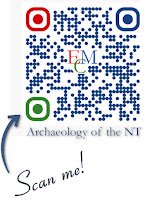VIDEO On the Pontius Pilate discoveries
In 1968,
archaeologist Gideon Foerster made an exciting discovery at the
Herodium, a fortress built by King Herod the Great in the Judean Desert.
Among the ruins, he found a copper-alloy ring with a unique design.
This ring would go on to be known as the “Pilate ring” and would shed
light on the religious and cultural connections between the Romans and
the people of Judea.
The ring features a Greek inscription that
reads “of Pilate.” This immediately caught the attention of scholars and
historians, as it is believed to have belonged to Pontius Pilate, the
prefect of the Roman province of Judea from 26-36 AD. This connection to
such a prominent figure in Roman history makes the Pilate ring a
significant archaeological find.
But what makes this discovery
even more intriguing is the research conducted by Dr. David Grave, a
professor of Classical Studies at the University of Florida. In his
article “Pilate’s Ring and Roman Religion,” Grave delves into the
symbolism and religious significance of the ring.
 |
| Drawing of the ring of Pilate in water color. My water colour illustration of Pilate's ring discovered at Herodium that was featured on the front cover of the Near East Archaeological Society Bulletin. Graves, David E. ‘Pilate’s Ring and Roman Religion’. Near East Archaeological Society Bulletin 69, no. 1 (2019): 1–20. For more on the name of Pontius Pilate see this article. |
The ring’s
design includes a depiction of a ritual vessel called a simpulum, which
was used in Roman religious ceremonies. The simpulum is a shallow bowl
with a long handle, used to pour wine or water as a libation to the
gods. This symbol is commonly associated with the Roman goddess Roma,
who represented the city of Rome and its people.
Grave argues
that the inclusion of the simpulum on the Pilate ring indicates a
connection to Roman religion and beliefs. He suggests that Pilate, in an
effort to maintain good relations with the Roman authorities, may have
adopted Roman religious practices and incorporated them into his rule.
Furthermore,
Grave points out that the inscription “of Pilate” on the ring is
written in the genitive case, which indicates ownership. This suggests
that the ring was not just a decorative item but was actually worn by
Pilate himself. This reinforces the idea that Pilate embraced Roman
culture and religion, as the ring would have been a symbol of his status
and loyalty to the Roman empire.
 | |
| Herodium interior Photo by David E. Graves |
But what makes the Pilate ring even more significant is the fact that it was found at the Herodium, a site closely associated with King Herod, a vassal of the Roman empire. This suggests that there were strong ties between the Roman and Judean rulers, and that Roman religious practices and beliefs may have influenced the Jewish elite.
The Pilate ring is a prime example of how archaeological finds can reveal valuable insights into the past. It not only confirms the existence of a prominent historical figure but also sheds light on the religious and cultural connections between the Romans and the people of Judea.
In conclusion, the Pilate ring discovered at the Herodium is a fascinating artifact that has opened up new avenues for research and study. Dr. David Grave’s article provides a thought-provoking analysis of the ring and its significance in understanding the religious practices of the Roman empire. It is a testament to the rich history and complex relationships between different cultures and civilizations.
For Pilate Ring Article see LINK
For more information on the Herodium see this blog article LINK
_________





No comments:
Post a Comment